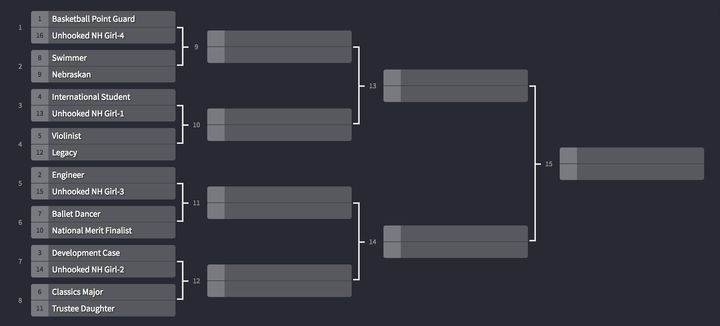
The College Admission Bracket
In the midst of March Madness, many of us obsess over our bracket, feverishly wondering—who’s going to win it all? With nearly equal intensity and fervor, college admissions committees will obsess over a different kind of bracket as they evaluate candidates from the various regions of the country and wonder who will make it through.
As college “ballers” battle it out on the court, it seems appropriate to explore the dealings behind the closed admission doors of their campuses. Often the perception is that admission offices are simply crunching numbers and, as "gatekeepers," haphazardly culling applicants based on a precise formula. While there is some truth in the numbers, the process is more complex and gut-wrenching for these seasoned educators. Admission officers often chose this career because of the joy of working closely with students and families, and as they shepherd students through the process, inevitably they become attached to the young people with whom they work. The overwhelming majority of colleges and universities in the United States have acceptance rates well over 50%, though the most selective colleges admit only 15-30% of their applicants. And of course there are a handful of “elite” institutions with single digit acceptance rates that dominate the headlines and feed the college admission frenzy. We live in a culture that can be obsessed with acceptance to a “top ranked” college as if a guarantee of future “success.” This contributes to an unhealthy fixation on credentials at all costs and is partly to blame for rising levels of anxiety among our young people (and their parents).
The reality of selective admission is that colleges simply cannot accommodate the many qualified students who can do the work, and who will offer positive contributions to a campus community. In fact, the sobering truth is that most “elite” colleges can enroll a bright, dynamic, diverse, talented freshman class three or four times over and the outcome will look virtually the same. Admission is a balance of competing needs and institutional priorities. For instance, is the male/female ratio on campus even or are there certain majors, sports teams, or music ensembles that need development? One school might be interested in young women who hope to pursue engineering and another college might want to find young men to round out their dance troupe. These priorities are not always immediately apparent to those outside the admission office, but along with financial restraints and enrollment goals, they help form the basis for final decisions, helping a student advance through the “bracket.”
Consider a highly selective, New England liberal arts college with an enrollment of 2,000 students and an overall admit rate of 15%. Out of an application pool of 8,000 candidates, the admission office is charged with bringing in a class of 500 first-year students. Let’s unpack these 500 spots to highlight the odds of acceptance for a young woman from New Hampshire without a specific “hook” or unique attribute that will serve as an incentive for admission:
500 students - 250 men for gender balance =
250 - 75 recruited athletes for 25 Division III women’s sports =
175 - 25 international students (14%) =
150 – 100 students from outside New England (2/3 geographic diversity) =
50 – 42 students from the other five New England states =
8 – 4 legacy students, development cases and other institutional priorities =
The Final Four
Projecting that not all of the admitted students will enroll, the college will make offers to twice as many students as there are spots. In our example, eight “unhooked” young women from New Hampshire will be accepted—less than 1% of the 8,000 original applicants.
As a former admission officer, March was the most difficult time of the process for me. I entered into committee excited about a group of admissible students from my region who would make great additions to the college. Then our Director would explain that we needed to trim the admission offers by thirty students. Each regional dean had to make the hard decision to deny admission to a handful of students who had excelled academically, performed great acts of service to their communities, and honed their extracurricular passions in unique ways. As their advocates we fought to keep them in the applicant pool, only to realize in the end that it was not possible to offer them admission. The only consolation was the near certainty that each student would find a school that was the right fit for both that individual and the institution. While ultimately one team will rise to the top of the NCAA basketball championship, it’s misguided and dangerous to think of admission in terms of “winning it all.” Though often difficult to remember in the "madness" as decisions are released this month, the college search is about finding the right match and ultimately attending a school that will value and welcome each student's strengths and contributions. Multiple institutions can provide these opportunities, despite potential disappointment or the outcome at any one school. Based on the research and writing of authors such as Charles Duhigg and Frank Bruni we know that future success is less dependent on where one goes, but rather influenced by how one approaches each challenge. Regardless of one’s seed or luck in the admission bracket, as long as applicants bring their best—acknowledging the imperfections and demands of the selective college admission process—they will honor their unique potential to advance in life.
